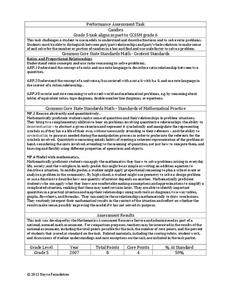Curated OER
Comprehension: Charlie and the Chocolate Factory
If your class will be reading Charlie and the Chocolate Factory, this guided reading worksheet may increase their comprehension. It asks them to re-read passages (provided) from the book and then answer numerous short answer questions. A...
Curated OER
Why Does the Cocoa Tree Need a Tropical Rainforest to Grow?
Fourth graders explore the requirements a cocoa plant needs to survive. They research where chocolate comes from and how humans can affect the growth of cocoa trees. Students create a 3-D model of a cocoa tree and compare and contrast...
Nosapo
Writing about a Meal
You don't need to be a food critic to describe your meal accurately! A series of activities introduce learners to vivid adjectives when writing about the taste, smell, and feel of food. After working with word choice, parts of a...
Curated OER
The Chocolate Touch
Students investigate concepts found in the reading of "The Chocolate Touch". They research where chocolate comes from and how it is grown. While the students read the book in small groups one member of each group brings in chocolate...
Noyce Foundation
Candy Fractions
While examining fractions and ratios, your leaners get to read about one of their favorite subjects: candy! There are four word problems on this worksheet. Learners consider situations in which "for every x caramels there are y...
Curated OER
Box of Chocolate Adjectives
Students practice using descriptive words. In this adjectives lesson, students are given a piece of candy and write as many descriptive words as they can about the candy. Students make sure to use descriptions that include all five...
Curated OER
Analyze The Learner; Chocolate Fractions
Third graders describe, represent and compare fractions using pieces of a chocolate bar. In this fractions lesson, 3rd graders demonstrate how to read and write fractions correctly. Students then integrate technology by using...
ELT-Connect
Happy Valentine's Day
Shelves filled with heart-shaped boxes of chocolates. Bouquets of red roses. Racks of romantic cards. Stores are preparing for Valentine's Day. Has the holiday become too commercialized? That is the question asked by a lesson designed...
Curated OER
Appositives and Present Participle Phrases (-ing word groups)
Combine sentences with the help of this grammar resource! Learn how to combine sentences using appositives and present participle phrases. The first page focuses on combining two sentences and creatine one. On page two, writers practice...
Curated OER
Seasons--Autumn (fall)
As part of a discussion of seasonal words, class members identify words relating to autumn and then identify the language used to describe what happens during this time of year.
Curated OER
"I'm Melting!"
Third and fourth graders engage with a worksheet designed to help them differentiate between melting and dissolving. After reading an informative paragraph about the two actions, they consider four scenarios, and choose whether they...
Greater Grace Christian Academy
Cereal Box Book Report
Need a creative idea for an elementary book report? Use a cereal box project to engage your readers beyond plot, setting, and characters. The lesson includes templates for the project and examples from Charlie and the Chocolate...
Teacher's Corner
Acrostic
Do your students suffer from metrophobia? Assuage their fears by asking them to craft an acrostic, a form poem that begins with a single word. The first in a series of ten poetry writing exercises.
Curated OER
Seasons: Summer
In this summer words worksheet, students analyze 36 words in a word bank and circle the "summer words". Students then read 10 sentences and from 4 choices, circle the correct word to describe summer.
Curated OER
Few and Less: A Confusing Pair
In this grammar worksheet, students learn the difference between the words "few" and "less" as well as adverbs and adjectives. They then answer the 14 questions on the page by inserting either few/fewer or less in the blank.
Curated OER
Photosynthesis Cookies
Learners identify photosynthesis as a process through which organisms make their own food. They practice the process for writing the formula for the photosynthesis equation.
Students describe how the processes of photosynthesis and...
Curated OER
Creative Writing Using the Senses
Fifth graders, utilizing a thesaurus to identify alternative word choices and meanings, eat a sweet treat and then list eight different adjectives for each of the five senses. They then describe a sweet with at least then adjectives...
Curated OER
Minerals of the Earth
Students learn and practice identifying Earth's minerals and their properties. Working in small groups, they evaluate minerals. This is a well-described lesson, which students enjoy.
Curated OER
10 Logic
In this algebra instructional activity, learners define and use not, and, or. They also discuss how biased or valid a test is. They apply logic to solving real life scenarios and word problems.
Curated OER
Tell Me More: Using Predicate Adjectives
In this predicate adjectives activity, students underline the predicate adjectives in 6 sentences. Students look for words that describe the subject.
Curated OER
Sour Acids and Bitter Bases
Students explore acids and bases. They experience the sour taste of acids and the bitter taste of bases by tasting substances such as chocolate, lemon juice, and baking soda. in addition, they complete a worksheet for individual assessment.
Curated OER
What Is It?
Students explore the likelihood of events. For this logical thinking lesson, 3rd graders are given several scenarios and determine whether the possibility of the described event actually happening is likely, unlikely, or...
Curated OER
Fields of Candy Bars
Students research and write about the origins of the ingredients in candy bars. They taste them and describe what they are tasting. They use descriptive words to write a paragraph describing the candy bar. They research ingredients in...
Curated OER
Total English Upper Intermediate: Enjoying Food!
In this countable and uncountable nouns worksheet, learners complete 8 sentences with the appropriate words from the word bank. Students also respond to 8 multiple choice questions involving countable and uncountable nouns.

























